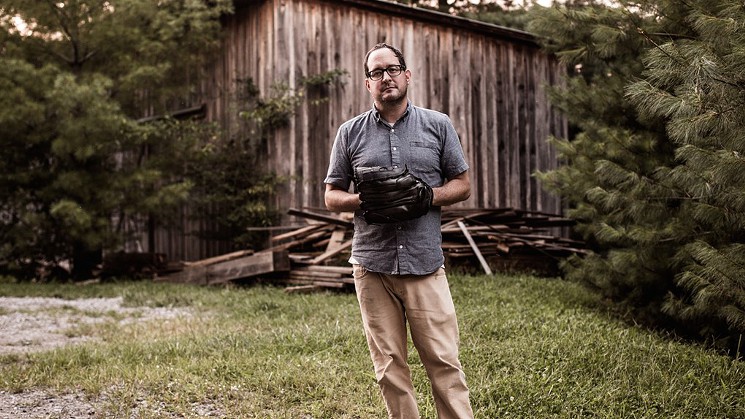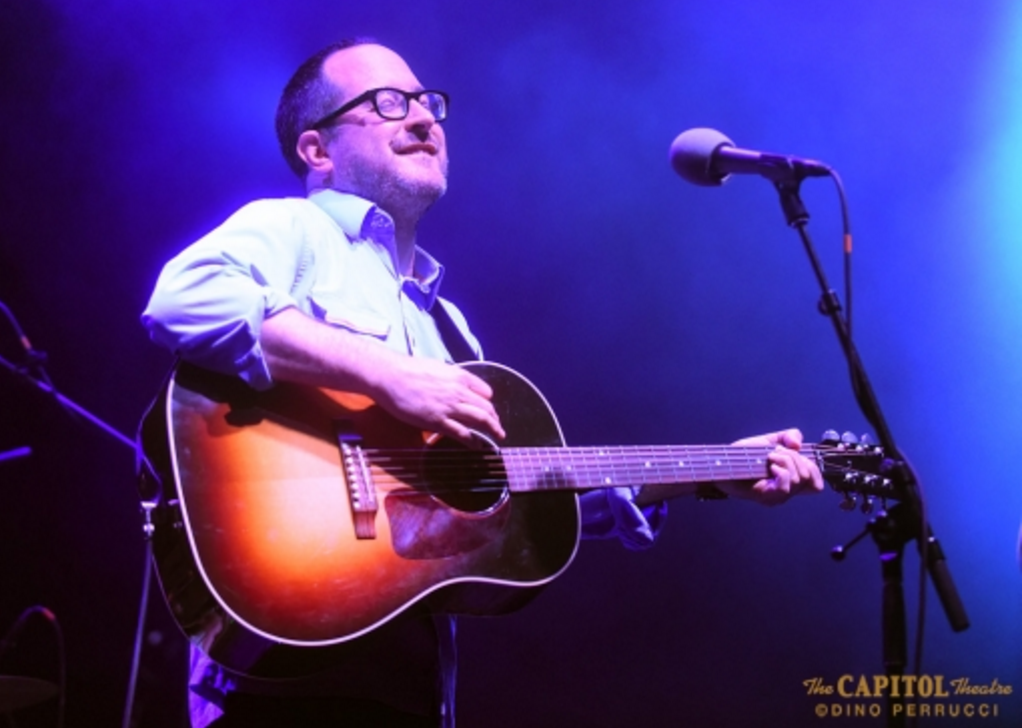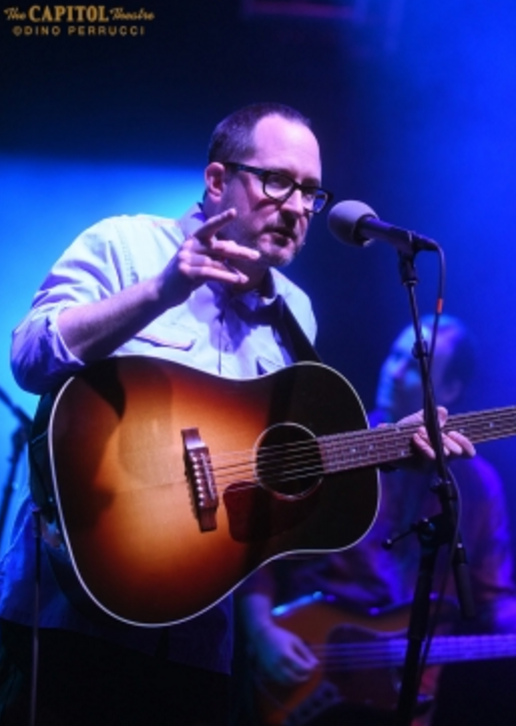Craig Finn: Keeping the ‘Faith’

“As an artist, I’ve just become more interested in the smaller moments of life,” says Craig Finn, surveying the intimate character portraits on his second solo LP, Faith in the Future. It’s ironic, then, that The Hold Steady’s frontman wrote this batch of new material in the aftermath of a major life event—the 2013 passing of his mother, Barbara.
“I didn’t really have a good way of putting what I was feeling into a song,” Finn says. “But what I was feeling was a lot of grief and anxiety. I got back to Brooklyn after my mother died. I was with her after the funeral and all that. I sat here in my apartment, and the days started going away. I wasn’t getting a lot done, and I thought, ‘This has to change. I need to do something.’ So I started working, and I started writing a lot of songs.”
Finn has always excelled as a narrative songwriter—weaving third-person tales of drug addicts, outlaws and outcasts into The Hold Steady’s cinematic alt-rock. That familiar work method helped him heal during a period of grief, as he explored themes of redemption and dogged optimism in the face of angst— like the polar-opposite relationship study of “Christine” and the 9/11 reflection “Newmyer’s Roof,” named after a friend who drank beers with Finn as they watched, in numb shock, as the towers fell.
“I definitely did not write about my mother passing, but when I look back, these things have a way of revealing themselves to you,” Finn admits. “I found that a lot of these songs were about people persevering through tragedy or change. I think it’s interesting that’s what the record ends up being about—getting up and having to face the future. I’m still writing about characters, but the characters aren’t engaged in such big struggles—they are dealing with smaller struggles, more realistic struggles.”
Finn, who grew up in Minnesota, has spent over a decade in one of rock’s most acclaimed bands—and outside of his 2012 solo debut, Clear Heart Full Eyes, that’s where he’s devoted his entire focus. But the intimacy of these new songs’ “smaller” details didn’t feel appropriate for The Hold Steady. (“I always say that in a Hold Steady song, someone usually gets shot or falls off a roof,” Finn says. “But that doesn’t happen in the solo stuff.”) Finn threw a few tracks into the band’s cumulative pile during the demo process for 2014’s Teeth Dreams, but there wasn’t any room for his mostly low-key slices of life.
“The Hold Steady tends to write in a specific way, at this point, where [guitarist] Tad [Kubler] comes up with the music and I come up with the words,” Finn admits. “If The Hold Steady was to do something with those songs, it would be kind of unusual. Usually, it wouldn’t start that way. So I wasn’t surprised or anything, or feeling any sort of rejection. It seemed they weren’t Hold Steady songs anyway. They certainly weren’t tossed off by those guys.”
Finn was determined to develop the material on his own. During the Holland stop on his recent European three-man songwriter tour with Patterson Hood (Drive-By Truckers) and Will Johnson (Centro-matic), he struck up a conversation with producer and former Yellowbirds member Josh Kaufman, who suggested they hit the studio in Woodstock, N.Y., with drummer Joe Russo to carve out a sonic path. Over nine months and three multi- day sessions, that core trio experimented with musical textures, trying to capture the essence of Finn’s lyrics with minimal interference.

“There was certainly no deadline,” Finn says. “No super plan, either.” The goal wasn’t exactly a “solo album”—more like a casual, “let’s just see what happens” that resulted in 16 songs, whittled down to a final 10. But Finn wasn’t completely flying by the seat of his pants either. He knew these songs begged to explore “a different mood” than The Hold Steady, and he worked diligently with Kaufman and Russo to figure that out.
“When you play a big rock song, you need big rock topics,” Finn says, comparing the album to his work with The Hold Steady. “Some of the solo stuff allows me to write about things that are a little more mundane— and allows me to be more personal, a bit more vulnerable. As I get older, that becomes more interesting to me.
“Josh and I talked about trying to get the narratives to come through,” he continues. “That was the priority in each song. All decisions were made on that. We’d start off with a very simple structure and have the narrative and the vocals there, and then we’d be like, ‘What else does it need? Let’s talk about only what it needs.’ Even the way Joe played drums— there’s very little cymbals on the record. And that is because cymbals, sonically, compete with vocals. Even though we certainly had drums, we produced them in a way where the narratives are front and center.”
Faith in the Future is largely minimal and acoustic, but never lacking in musical detail. The strutting “Saint Peter Upside Down” explores childhood betrayal via crucifixion metaphors, backed by moaning brass and sighing harmony vocals; the inquisitive “Roman Guitars,” written on a friend’s son’s toy guitar, ponders the molecular randomness of morality over flanged pianos and jazzy saxophone.
“It could be a feel thing, oftentimes,” Finn says of the album’s creative process, emphasizing Kaufman and Russo’s crucial arrangement contributions. “With ‘Roman Guitars,’ we kind of put a lurch in there, a swing that it didn’t have when we brought in the song. That’s something Josh and Joe put in. My version, when I look back, was…just not as good.”
A perfect example of that collaborative marriage is “Sandra From Scranton,” in which Finn observes a lonely woman lost in her own memories of a failed relationship. “Shake off the shadows,” he begs her, as weepy electric guitar leads and droning tom-toms fill the silence. “Wipe the grime from the windows.”
“It’s certainly about people who’ve gotten a little older, aren’t going out all the time,” he says of the subdued track. “Sonically, I had it one way, but Josh had the vision for keeping it slow with those drums. It’s kinda spooky and sad. I think Josh really got the lyrics and created a sound that matched them.”
Finn has always been a people watcher, happy to live as a stranger in a crowd of strangers. On the breezy, quietly percussive “Going to a Show,” he summarizes that feeling in the context of attending a rock concert by himself. (“I try so hard not to talk to myself,” he sings, in that plainspoken warble. “But it’s hard ‘cause I’m always alone.”)
“As a touring musician, you go to a city on a tour bus and the bus parks,” he says. “And you want to get coffee. And in America, walking in some places is weird. Just the fact that you’re walking a half- mile to Starbucks, but you’re doing it on a frontage road. A lot of time, being a touring musician is time spent alone. I think, in that sense, being at a show alone is a similar thing. I like going to shows alone because I don’t have to worry about anyone else liking the music. I’ve always liked that—always enjoyed going to shows alone. I think the touring lifestyle is good for me. I like being around people but alone. I like cafés. I like going to movies alone. That’s why New York is a great place to live—because you’re always alone, but you’re surrounded by people.”

The album’s most vivid portrait is the stirring, Springsteen-like strum of “Christine,” which depicts the complicated trajectory of the restless title character, darting across the country in search of meaning, and the cautious narrator, who watches her spontaneity with both jealousy and resentment. “Everyone wants somethin’,” Finn sings, sadly and wisely. “I just want Christine.”
“I identify with the narrator,” he says. “Maybe he’s overthinking it. That one kinda came together a little more off-hand in the studio, as we changed some things. The line we thought was funny, when we recorded it, is when she says, ‘Let’s move to the city/ Stay up all night, live the high life,’ and he says, ‘Maybe first we visit, make sure that we like it.’ I thought that was really funny. I think of the two characters, Christine and the narrator, as two opposite ends. She’s flighty, but maybe too much so. And he’s too careful. In the meantime, because of that, they’re kind of stuck with each other.”
Finn doesn’t bury the lead on Faith in the Future—despite the minor crises that populate these songs, the overarching theme is the workmanlike determination to keep trudging through life, no matter what. Like his characters, the frontman is full of layered complications. A semi- lapsed Catholic, he still attends Mass on occasional Sundays, letting his mind drift—mostly because the surroundings give him comfort. “The church is a very contemplative place, and it connects me to people in my family, who are Catholic,” he says. “There’s comfort in the rituals, so to speak. I can’t say I’m always concentrating on the reading or the sermon. I might be in my own place, but it’s a place I can go to get to a good place.”
But the titular Faith isn’t specifically spiritual. It is actually more practical. He may be constantly bombarded by horrible headlines, but Finn finds comfort in casual acts of kindness that permeate the peripheries of everyday life. Just like with his songs, those “small details” add up to a big picture—you just have to catch enough of them.
“I find optimism in small things: friendships, love that I’ve found with the woman I’m with,” Finn says.
“Yes, you turn on the news, and it’s terribly depressing at times. But there are acts of love all around us that I take my optimism from. I see it all the time in New York. And I think it’s a good example because it’s a city where you have to cooperate with each other. Seeing the guy carry a woman’s stroller up the stairs—without too much talking about it! That’s good. It doesn’t block out some of the terrible things, but finding moments like that helps me stay optimistic.”



















